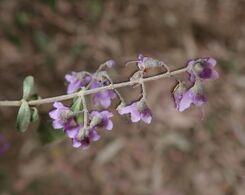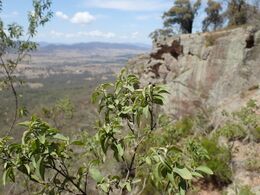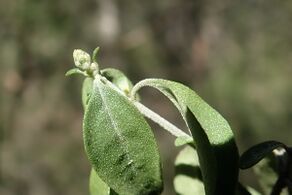Biology:Prostanthera cineolifera
| Singleton mint bush | |
|---|---|
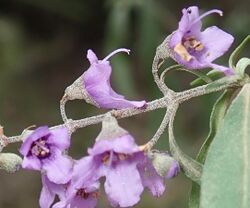
| |
| Scientific classification | |
| Kingdom: | Plantae |
| Clade: | Tracheophytes |
| Clade: | Angiosperms |
| Clade: | Eudicots |
| Clade: | Asterids |
| Order: | Lamiales |
| Family: | Lamiaceae |
| Genus: | Prostanthera |
| Species: | P. cineolifera
|
| Binomial name | |
| Prostanthera cineolifera R.T.Baker & H.G.Sm.[1]
| |
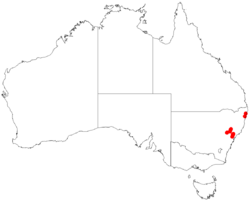
| |
| Occurrence data from AVH | |
Prostanthera cineolifera, commonly known as the Singleton mint bush,[2] is a species of flowering plant in the family Lamiaceae and is endemic to eastern New South Wales. It is an erect shrub with hairy branches, narrow egg-shaped leaves and clusters of pale mauve to dark purple-mauve flowers arranged on the ends of branchlets.
Description
Prostanthera cineolifera is an erect, strongly aromatic shrub that typically grows to a height of 1–4 m (3 ft 3 in–13 ft 1 in) with hairy, glandular stems. The leaves are narrow egg-shaped, light green, 12–50 mm (0.47–1.97 in) long and 4–12 mm (0.16–0.47 in) wide on a petiole 2–7 mm (0.079–0.276 in) long. The flowers are arranged in clusters at the ends of the branchlets with bracteoles 1–2 mm (0.039–0.079 in) long that fall off as the flowers develop. The sepals are 3–4 mm (0.12–0.16 in) long and form a tube 2–2.5 mm (0.079–0.098 in) long with two lobes, the upper lobe 1–2 mm (0.039–0.079 in) long. The petals are pale mauve to dark purple-mauve, 8–12 mm (0.31–0.47 in) long, and fused to form a tube that is darker on the inside. Flowering occurs from September to October.[2][3]
Taxonomy
Prostanthera cineolifera was first formally described in 1912 by Richard Thomas Baker and Henry George Smith in Journal and Proceedings of the Royal Society of New South Wales.[4][5]
Distribution and habitat
Singleton mint bush has been observed in scattered localities in New South Wales including at Apsley Falls near Walcha, and at scattered places in the Hunter Valley. It grows in forest and woodland on exposed ridges.[3][6]
Conservation status
This mintbush is classified as "vulnerable" under the Australian Government Environment Protection and Biodiversity Conservation Act and the New South Wales Government Biodiversity Conservation Act 2016. The main threats to the species include inappropriate fire regimes and its apparently small population size.[2][6]
References
- ↑ "Prostanthera cineolifera". Australian Plant Census. https://biodiversity.org.au/nsl/services/apc-format/display/109437.
- ↑ Jump up to: 2.0 2.1 2.2 "Singleton mint bush - profile". New South Wales Government Office of Environment and Heritage. https://www.environment.nsw.gov.au/threatenedspeciesapp/profile.aspx?id=10672.
- ↑ Jump up to: 3.0 3.1 Conn, Barry J.. "Prostanthera cineolifera". Royal Botanic Garden Sydney. https://plantnet.rbgsyd.nsw.gov.au/cgi-bin/NSWfl.pl?page=nswfl&lvl=sp&name=Prostanthera~cineolifera.
- ↑ "Prostanthera cineolifera". APNI. https://id.biodiversity.org.au/instance/apni/540839.
- ↑ Thomas, Richard Thomas; Smith, Henry George (1912). "On a new species of Prostanthera and its essential oils.". Journal and Proceedings of the Royal Society of New South Wales 46 (1): 103–110. https://www.biodiversitylibrary.org/page/41676470#page/133/mode/1up. Retrieved 27 August 2020.
- ↑ Jump up to: 6.0 6.1 "Approved Conservation Advice for Prostanthera cineolifera". Australian Government Department of the Environment. http://www.environment.gov.au/biodiversity/threatened/species/pubs/11233-conservation-advice.pdf.
Wikidata ☰ Q15355450 entry
 |


